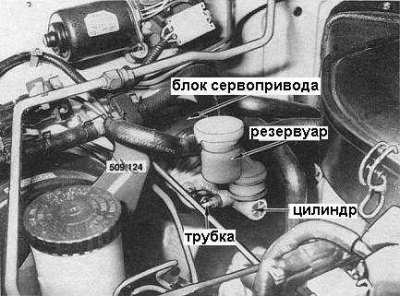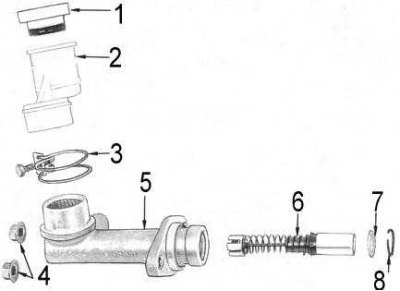Removing
Clutch Master Cylinder Location on 4.2L Models

1. Cover the right front mudguard with protective covers.
2. Disconnect the hydraulic tube from the master cylinder. Seal the end of the tube and bore in the cylinder to prevent dirt from entering the hydraulic system and to minimize fluid loss.
3. On 3.0L models, disconnect the master cylinder pusher from the clutch pedal.
4. Give fixing nuts and remove the main cylinder from the car. Try not to let hydraulic fluid get on the painted surfaces of the body.
Attention! If hydraulic fluid comes into contact with the paintwork, immediately wash it off with plenty of water, then allow the surface to dry naturally - do not wipe it with a rag.
Installation
Installation is in the reverse order.
1. Tighten the fixing nuts to the required torque.
2. Bleed the hydraulic system.
Disassembly
1. After removing the master cylinder, drain the hydraulic fluid from its reservoir.
2. Loosen the clamp and separate the reservoir from the master cylinder.
3. Separate the rubber boot from the end of the master cylinder.
4. Remove the circlip from the end of the cylinder, then (in accordance with the package) remove the pusher, washer and rubber boot.
5. Remove the piston and spring assembly from the cylinder (see accompanying illustration - master cylinder components shown for 4.2L models).

1 - cover; 2 - reservoir; 3 - clamp; 4 - nuts; 5 - cylinder; 6 - piston; 7 - washer; 8 - retaining ring
Cleaning and checking the condition
1. Wash all master cylinder components with methanol.
Attention! Never use gasoline or mineral spirits for this purpose.
2. Check the cylinder bore for signs of wear and corrosion and replace if necessary.
Attention! Honing the clutch master cylinder is not permitted. If significant defects are found in the mirror, the cylinder assembly should be replaced.
3. Check the piston assembly for signs of wear, scratches, nicks and corrosion. Pay special attention to the condition of the piston cuffs. Replace if necessary.
4. If equipped, check the tappet and washer for signs of wear and damage. Replace defective components.
5. Check the hydraulic fluid reservoir for cracks or other damage. Replace if necessary.
6. Check up serviceability of a condition of a collar of fastening of the tank. Replace if necessary.
Assembly
Note. Where possible, be sure to use special repair kits that include new cuffs and a piston. The use of such branded kits will greatly extend the life of the unit.
1. Lubricate with special grease (for rubber components) piston collar, cylinder mirror and, if equipped, a rubber boot.
2. Install the piston/spring assembly into the cylinder. On 4.2L models, install washer and new circlip.
3. On 3.0 l models, check the presence of a rubber boot on the pusher, then install and secure the pusher with washer with a new retaining ring. Pull the protective cover over the cylinder body.
4. Install the reservoir on the master cylinder and secure it securely with a clamp.
5. Fill the reservoir with fresh hydraulic fluid, then pump the piston by hand until fluid appears in the hydraulic tube fitting hole on the cylinder body.
6. Install the master cylinder to the vehicle.